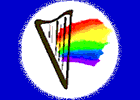














| Your Cheatin' Harp by Louise Trotter [This article first appeared in The Harp Column, Nov/Dec 2000, p. 32.] If you're a harp player, are the terms drone, hammer-on, reverse roll, walking bass, and tremolo in your usual vocabulary? Have you in the audience ever seen a harpist in a bandanna-print blouse, denim skirt and cowboy boots? Yee-haw! Get ready to ride! |

|
||
|
The harp can be a versatile instrument, with repertoire ranging from
classical to folk to popular music of every variety. As a native Texan,
I have always been aware of how much people enjoy country-western music,
and I usually include it in my playlist if it suits the occasion. A few
ornaments can add a country flavor to any song, and audiences react with
surprise and delight to hear their favorite tunes played on the harp. Rooted in our folk heritage, American country music has simple melodies and uncomplicated harmonies. There are seldom more than three or four different chords in a song, and rarely if ever any modern harmony, thus it is accessible to lever as well as pedal harp players. Although traditional instruments for country-western music are guitar, banjo, fiddle, string bass, and piano, the harp and its plucked percussive sound can imitate any of these. With origins in folk music, many tunes evolved over the years into hillbilly or cowboy songs, such as those made popular by movie stars like Roy Rogers and Gene Autry. Later, a style called "western swing" was played by Bob Wills and his Texas Playboys. More recently, recording stars such as Garth Brooks and Dolly Parton have been singing popular country tunes, though their renditions bear little resemblance to the earlier versions. In the 1970s, Floyd Cramer developed a country-western style on the piano with ornaments that work especially well on the harp. His are the ornaments and musical devices that I would like to share with you in hopes that they and you will enrich your repertoire. The easiest songs to ornament are slow in tempo, with several beats' rest at the ends of phrases. Most tunes have a 4/4 or 3/4 time signature. Take care to use the following effects for only a few measures at a time so they will not be overdone and lose their impact. To demonstrate each example, I've used the familiar American melody "Home on the Range"  Drone One of the more important sounds in country music is the drone, a harmonizing line played an interval above the melody notes.  Hammer-on, Pull-off A hammer-on takes its name from the guitar term in which a finger is placed on the fret after the string is plucked, giving a rising grace note or slide effect. On the harp, the second and third fingers play two strings one after the other, while the thumb plays the drone harmony above them (example 3). A pull-off is the reverse: the slide consists of descending notes (example 4).   A reverse roll is very simple: it is a chord played from top to bottom, rather than the usual bottom to top rolled chord. One good place for this would be as a "fill" at the end of a phrase (example 4). Walking Bass A walking bass has a single note or octave bass line progressing from the root of one chord to the root of a new chord. It can be used as an intro to the piece, or as pick-ups notes at the beginning of a phrase or to a repeat or second ending. There are usually not more than three or four notes "walking" (example 5, measures 2 and 4).  Tremolo A tremolo is a rapid oscillating effect, in sixteenth notes or triplets, either an octave apart or in intervals of a sixth. It is used to sustain the sound in the same way a pianist would hold down the sustain pedal. A tremolo can be used in place of longer notes like half, dotted half, or whole notes (example 6, measures 2 and 3).  Pedal or Lever Slide A pedal or lever slide, achieved by moving a lever or pedal while a string is still sounding, is one of the most effective country-western devices on the harp because the sound of the slide so closely imitates the guitar (example 7, from "Blue Eyes Cryin' in the Rain"). If you play with the nail you can achieve a good imitation of the sound of a guitar. A slide can be used as part of the melody or the harmony. On a pedal harp, you can do a slide in harmony using a pedal on each side and changing them at the same time.  Remember that most country-western songs were written with words to be sung. With the help of these effects, harpists can provide a strong sense of melody to compensate for the absence of a vocal line. Some Titles Are you ready to try playing country-western harp? These popular songs are a good place to start, and will surely help to diversify your repertoire: "Your Cheatin' Heart" "Blue Eyes Cryin' in the Rain" "Tennessee Waltz" "King of the Road" "Last Date" "San Antonio Rose" "Crazy"
|
|||
Historical Harp | Folk and World Harp | Pedal Harp |
Harp Building | Harp Works | Non-Harps |
Camps & Concerts | Links | Glossary |
Donate! | Get Involved! | Contact Us | About Harp Spectrum
Copyright 2002 - 2017, Harp Spectrum All Rights Reserved